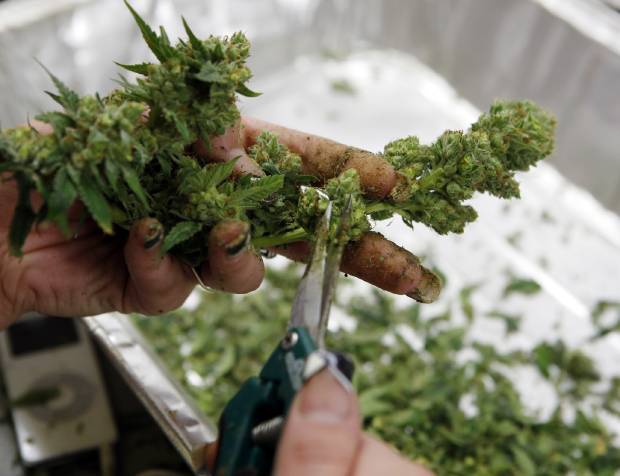Fascinating Update at https://newrevenue.org/2014/09/22/rose-habib-on-the-bud-trim-line/ — sophisticated analysis from an industry expert, who knows far more than I.
Context: Colorado is de facto imposing wholesale per-gram marijuana taxes: 62 cents for potent bud, or flowers, and 10 cents for less valuable trim, or leaves. New Approach Oregon’s prominent 2014 initiative would tax bud at $1.23 a gram, trim at 35 cents. Rhode Island Senate Bill 2379 would tax “dried flowers” at $1.76 per gram, and “all other parts” of the plant at 35 cents. Alaska’s predicted-to-pass 2014 initiative would tax at $1.76 per gram, too, but would allow a tax cut for parts of the plant that aren’t so valuable or so potent.
Problem: “It would be impractical to try to establish legally enforceable standards of how well trimmed a bud can be before it is no longer legally a bud.” That’s from After Legalization, by Jon Walker. Phil Smith calls the book “in-depth, thoughtful, and insightful.” http://stopthedrugwar.org/chronicle/2014/apr/29/marijuana_past_and_future,
Update: Here is a 40-second video of a mechanical separator of bud and trim — but we don’t see the results (url https://www.youtube.com/watch?v=DYDX_8JSygg). Maybe that kind of thing device be calibrated with a certain size of openings and a certain duration of operation to yield bullet-proof, replicable results. Maybe.
Revised link: Here is a long video of hand separation of bud and trim. https://www.youtube.com/watch?v=GOtsu-BKuys. Or search youtube with trim marijuana hand.
Phil Smith calls the book “in-depth, thoughtful, and insightful.” http://stopthedrugwar.org/chronicle/2014/apr/29/marijuana_past_and_future,
A longer quote from the book is here: “The issue with a per-ounce tax is that it creates too many practical problems. There are too many ways to game this system, and with a large tax, plenty of incentive to try. Someone could remove only the trichomes from the buds to create very potent kief. This higher THC-per-ounce product would be a way to avoid most of the tax. It would be impractical to try to establish legally enforceable standards of how well trimmed a bud can be before it is no longer legally a bud.” Page 66, Kindle version, footnote omitted.
Reactions: Preparing to write on this issue as part of a broader piece, I’ve solicited reactions. If all goes well, I may take excerpts from the quotes, then link here in footnotes in a more coherent fashion.
A source in Colorado government:
Currently, we separate marijuana into three categories for the purposes of applying Colorado’s excise tax on recreational marijuana: bud, trim, and immature plants. We then set the average market rate per pound for each category to apply the 15% excise tax. We have also promulgated regulations to address the situation in which marijuana is concentrated.
We respectfully disagree with Mr. Walker’s position on this issue. We believe Mr. Walker misunderstands the retail marijuana market. There is no incentive for a marijuana cultivator to separate more trim than is needed, as marijuana is typically most valuable in the bud form, which is in turn sold at retail by weight. This is why most marijuana infused products such as edibles are created with trim, not bud.
No issues have been brought to our attention regarding this approach. In fact, we believe there is a rather bright line as to what constitutes bud and trim, simply because of the retail market value of each.
This model is enforceable. Marijuana is tracked from cultivation to sale through MITS. If bud was improperly reported as trim in an effort to avoid the tax, the discrepancy would be reflected at the point of sale, unless the retailer sold the bud for the price of trim, but why would a retailer do that?
Dave Kopilak, an attorney representing New Approach Oregon and, a lead writer of their 2014 initiative:
“Taxing flowers and leaves at different rates makes economic and logical sense, and we do not anticipate any practical problems determining flowers from leaves. The Oregon Liquor Control Commission has broad rulemaking authority and, to the extent necessary, can promulgate regulations to more specifically define the two categories and ensure that the taxes are assessed fairly, accurately, and in their intended manner.”
Jon Walker:
Since the tax is relatively small and regulators are going to be changing the rules as things develop I don’t think aggressive scheme to exploit some loophole would really make much sense.
A possible problem, only if specific future conditions are met. I doubt it is a problem in Colorado right because it probably doesn’t make financial sense to save a very small amount by getting a trim tax rate but also reducing the amount of bud you can sell. I won’t be surprised if bud had a better overall margin at the moment.
I’m not trying to write about the current state of the marijuana industry, but instead trying to predict where it will be after over a decade of innovation, investment and technological improvement combined with a much better political environment. Things will likely change significantly in the coming years.
Further thoughts (PO): There’s not much of a loophole unless bud is more useful than trim for making concentrates. Might not a tax-evader deliberately characterize bud as trim to boost the THC content – and thus value – of concentrates? That evasion depends on the purchaser believing that he is getting a better, more valuable product — edible, vaporizer cartridge, or whatever. And that belief would need to come from THC labeling (however inaccurate) or some other claim or experience or report.
If CO accurately calculates “average market rates” to base its weight taxes on, those rates should reflect markups through the supply chain. So bud and trim should have similar margins. Should.
More questions: what’s the right ratio of bud tax to trim tax? Base it on market value or THC content? CO has 6.2 to 1; NAOR, 3.5 to 1; RI bill, 5 to 1.

7 thoughts on “Can the bud-trim line hold?”